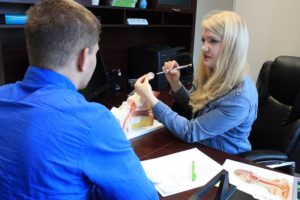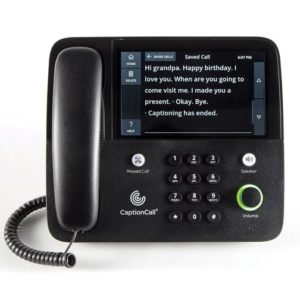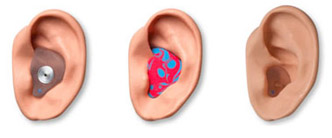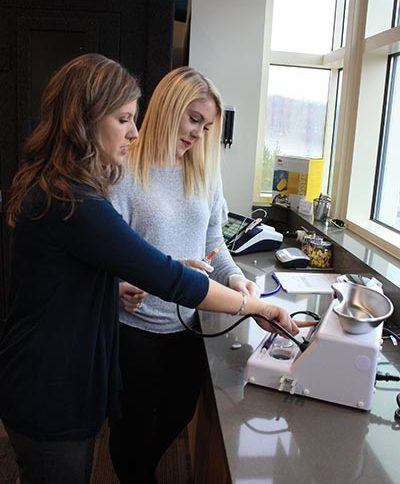 Audiological Evaluations
Audiological Evaluations
An audiological evaluation is a battery of diagnostic procedures completed in order to determine the severity, type, and configuration of an individual’s hearing and understanding status. Our clinic accepts self-referrals, physician referrals, and referrals from other healthcare professionals.
What to expect:
When you arrive for your hearing evaluation, you will be greeted by a student clinician who will ask you to fill out several forms that will include your personal information, medical history, hearing difficulties, and medical record privacy information. When your hearing evaluation begins, you will be asked a few questions to better acquaint the audiologist with the listening difficulties you may be experiencing.
The audiologist will then look into your ears to make sure the ear canal and eardrum is healthy and clear. Once this is determined, a test of middle ear function will be completed to check the mobility of the eardrum and make sure the middle ear is clear of any abnormalities such as excessive fluid build-up, disconnected bones, etc.
Next, the hearing exam will be completed in a soundproof booth by a licensed audiologist or an audiology student clinician under the direct supervision of an audiologist. While in the booth, you will hear a series of low to high pitched tones as well as speech that you will be asked to respond to. This will help us determine the percentage of understanding for basic conversation in quiet. The results of the testing enable the audiologist to know whether or not a hearing loss exists, what the cause of the hearing loss may be, and the severity and type of the hearing loss. In return, you and the audiologist will compile a treatment plan that will best fit your hearing and communication needs. Specialized protocols may be needed to assess infants and young children.
INFORMATION
For more information on audiologic evaluations and the characteristics (type, degree/severity, configuration) of hearing loss, visit:
Assistive Listening Devices
While hearing aids may improve the communication abilities for many individuals with hearing loss, using them alone may not enhance all areas of listening difficulty. Assistive listening devices (ALDs) can be used alone or in addition to hearing aids or cochlear implants to improve the patient’s abilities beyond the hearing aids and to decrease the limitations of all types of hearing loss. ALDs are devices that separate a signal from environmental noise and can help improve hearing in difficult listening situations such as background noise, poor room acoustics/reverberation, and distance between listener and speaker. ALDs provide technology that increases awareness of environmental sounds for not only communication purposes but safety and improved quality of life. Assistive listening devices can also be referred to as assistive hearing devices, assistive listening technology, hearing assistive technology systems (HATS), and auxiliary aids.

Some examples of Assistive Listening Devices:
- FM systems
- Sound field systems
- Looping systems
- Infrared systems
- Amplified telephones
- Captioning telephones
- Amplified alarm clocks
- Hearing assistive dogs
- Amplified door bells
- Amplified baby monitors
- Fire alarm/smoke alarm
- Note-taking technology
- Video calling
- Video relay service
- Real-time captioning
- Hearing device options
Custom Hearing Protection, Musician Earplugs, and Swim Molds
Custom hearing protection/ear plugs, musician plugs, and swim molds can be tailored for each unique patient and their needs. Earmolds are made to fit the size and shape of each unique ear and come in different styles and colors. The process of creating a custom earmold ensures a proper fit that is comfortable and reliable for the patient. To complete the process, an earmold impression appointment is necessary. At the appointment, an audiologist will make a casting of the individual’s ear that will be used to create the custom earmold.
Hearing protection is crucial to preserve and prevent hearing loss in environments where loud sounds are common. Wearing protection will help to prevent noise-induced hearing loss and preserve any residual hearing for those already diagnosed with hearing disorders. Some common sources of loud noise exposure include machinery in the workplace, firearms, concerts, lawn equipment, power tools, motor sports, sirens, and music through earbuds.
Swim molds are used to keep water out of the ears during activities such as swimming or bathing. These molds are a perfect solution for clients who have had tubes placed in their ears or those who suffer from recurrent swimmer’s ear (otitis externa) and/or ear infections. The custom swim mold provides a tight but comfortable seal to prevent water from entering the ear.

Hearing Aid Fittings and Services
 West Liberty University Speech and Hearing Clinic offers state-of-the-art hearin
West Liberty University Speech and Hearing Clinic offers state-of-the-art hearin
At home hearing aid maintenance is an easy way to keep your technology in good working condition. Proper daily cleaning with a dry cloth or cleaning brush, opening the battery doors and storing the devices in a safe place at night, keeping them away from direct moisture and animals, and daily visual checks will increase the life of the hearing aids. If you are in need of a hearing aid maintenance kit, our clinic has just the supplies you need to make your hearing aid care easy and convenient!
Speech-Language Pathology Services
Speech-language pathology services include the evaluation and treatment of individuals with a variety of communication and swallowing disorders. Communication disorders are present in children and adults of all ages and may include speech disorders (articulation, fluency, or voice disorders), language disorders (related to the form or function of language), and cognitive/linguistic disorders (related to attention, perception, memory, reasoning, problem solving, thought organization, planning or insight). Feeding and swallowing evaluations and treatment may include diet modifications, postural adjustments, strategies to improve airway protection, oral and pharyngeal exercises, adaptive utensils and cups, and referrals for imaging studies and oral prosthetics.
Speech and Language Evaluations
A speech and language evaluation is a battery of diagnostic procedures completed in order to determine the status of an individual’s communication needs. Our clinic is currently accepting pediatric patients ages birth-adult. We accept self-referrals, physician referrals, and referrals from other health care professionals.
What to Expect
When you arrive for a speech and language evaluation, you will be greeted by a student clinician who will ask you to fill out several forms that will include your personal information, medical history, and medical record privacy information.
The speech and language evaluation will be completed by a licensed speech-language pathologist or a speech pathology student clinician under the direct supervision of a speech-language pathologist. This evaluation may include a combination of formal and informal assessments in the areas of need. Evaluations may include formal protocols, such as naming and speaking tasks, oral and written comprehension, and conversational samples. An examination of the oral peripheral mechanism may also be completed by the speech-language pathologist. Video or audio recordings may take place to assist in transcription of speech and language skills. The results of the testing assist the speech-language pathologist in the identification of a speech and language disorder. At the completion of the evaluation, you and the speech-language pathologist will compile a treatment plan that will best fits your communication needs.
Information:
- Speech Development
- Early Identification of Speech Language and Hearing Disorders
- What is a Speech-Language Pathologist?
- What is a Communication Disorder?
- Childhood Speech and Language Disorders
- Parent Resources for Developmental Norms for Speech and Language
- Speech and Language Development.
- Speech and Language Evaluations in the Schools
- Adult Speech and Language Disorders
Speech and Language Treatment
Articulation
Articulation is the formation of clear and distinct speech sounds. Articulation disorders or delays may be characterized by substitutions, omissions, additions, or distortions of speech sounds, causing speech to be difficult to understand. Treatment in articulation may target specific sound deviations or groups of sounds with similar patterns.
Language
Language is the method of human communication, either written or spoken. It may include the understanding of language, as well as the ability to use verbal language to communicate. A language disorder may involve the form, content, or use of language required for communication. Treatment may include stimulation of specific language forms and skills that allow an individual to enhance everyday communication and increase access to academic and social communication.
Fluency
Fluency is the smoothness or flow with which words, syllables, words and phrases are joined together when speaking quickly. Disorders in fluency are called stuttering or cluttering. These disorders cause breaks in the fluidity of speech, and are displayed by repetitions or blocks in speech. Treatment includes the teaching of strategies needed to improve fluency and decrease stuttering.
Voice
Voice refers to the quality, pitch, loudness, tone, or duration of one’s vocal quality. A voice disorder may include any or all of these characteristics affecting an individual’s ability to speak easily. Treatment may include a combination of direct and indirect techniques to address the disorders and contributing vocal habits.
Feeding and Swallowing
Swallowing refers to one’s ability to safely tolerate foods, drinks, and saliva. An interruption to a person’s swallowing function may manifest in loss of food or liquids from the oral cavity, coughing or choking when eating, nasal reflux, pain during the swallow, or even unexplained chronic regurgitation. Swallowing disorders (also known as dysphagia) may put people at risk for malnutrition, dehydration, aspiration pneumonia, social isolation due to the fear of choking in the presence of others, and/or overall compromised health. Treatment may include diet modifications, postural adjustments, strategies to improve airway protection, oral and pharyngeal exercises, adaptive utensils and cups, and referrals for imaging studies and oral prosthetics.
Cognitive/Linguistic Treatment
Cognitive-Linguistic aspects of communication involve attention, perception, memory, reasoning, problem solving, thought organization, planning, and insight. A person may have difficulty with organizing thoughts for everyday tasks such as meal planning, cooking, managing medications, driving, remembering names and places, accuracy with managing finances, and more. Treatment is individualized to meet the person’s specific cognitive-linguistic needs but typically includes memory strategies and/or exercises to improve the underlying cognitive deficits that are inhibiting functional communication skills.
